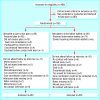Effect of joint crisis plans on use of compulsory treatment in psychiatry: single blind randomised controlled trial
- PMID: 15240438
- PMCID: PMC478218
- DOI: 10.1136/bmj.38155.585046.63
Effect of joint crisis plans on use of compulsory treatment in psychiatry: single blind randomised controlled trial
Abstract
Objective: To investigate whether a form of advance agreement for people with severe mental illness can reduce the use of inpatient services and compulsory admission or treatment.
Design: Single blind randomised controlled trial, with randomisation of individual patients. The investigator was blind to allocation.
Setting: Eight community mental health teams in southern England.
Participants: 160 people with an operational diagnosis of psychotic illness or non-psychotic bipolar disorder who had experienced a hospital admission within the previous two years.
Intervention: The joint crisis plan was formulated by the patient, care coordinator, psychiatrist, and project worker and contained contact information, details of mental and physical illnesses, treatments, indicators for relapse, and advance statements of preferences for care in the event of future relapse.
Main outcome measures: Admission to hospital, bed days, and use of the Mental Health Act over 15 month follow up.
Results: Use of the Mental Health Act was significantly reduced for the intervention group, 13% (10/80) of whom experienced compulsory admission or treatment compared with 27% (21/80) of the control group (risk ratio 0.48, 95% confidence interval 0.24 to 0.95, P = 0.028). As a consequence, the mean number of days of detention (days spent as an inpatient while under a section of the Mental Health Act) for the whole intervention group was 14 compared with 31 for the control group (difference 16, 0 to 36, P = 0.04). For those admitted under a section of the Mental Health Act, the number of days of detention was similar in the two groups (means 114 and 117, difference 3, -61 to 67, P = 0.98). The intervention group had fewer admissions (risk ratio 0.69, 0.45 to 1.04, P = 0.07). There was no evidence for differences in bed days (total number of days spent as an inpatient) (means 32 and 36, difference 4, -18 to 26, P = 0.15 for the whole sample; means 107 and 83, difference -24, -72 to 24, P = 0.39 for those admitted).
Conclusions: Use of joint crisis plans reduced compulsory admissions and treatment in patients with severe mental illness. The reduction in overall admission was less. This is the first structured clinical intervention that seems to reduce compulsory admission and treatment in mental health services.
Figures
Comment in
-
Compulsion and psychiatry--the role of advance statements.BMJ. 2004 Jul 17;329(7458):122-3. doi: 10.1136/bmj.329.7458.122. BMJ. 2004. PMID: 15258044 Free PMC article. No abstract available.
-
A joint crisis plan negotiated with mental health staff significantly reduces compulsory admission and treatment in people with severe mental illness.Evid Based Ment Health. 2005 Feb;8(1):17. doi: 10.1136/ebmh.8.1.17. Evid Based Ment Health. 2005. PMID: 15671508 No abstract available.
Similar articles
-
Joint crisis plans for people with psychosis: economic evaluation of a randomised controlled trial.BMJ. 2006 Oct 7;333(7571):729. doi: 10.1136/bmj.38929.653704.55. Epub 2006 Aug 16. BMJ. 2006. PMID: 16914458 Free PMC article. Clinical Trial.
-
CRIMSON [CRisis plan IMpact: Subjective and Objective coercion and eNgagement] protocol: a randomised controlled trial of joint crisis plans to reduce compulsory treatment of people with psychosis.Trials. 2010 Nov 5;11:102. doi: 10.1186/1745-6215-11-102. Trials. 2010. PMID: 21054847 Free PMC article. Clinical Trial.
-
[Advanced directives in psychiatry: A review of the qualitative literature, a state-of-the-art and viewpoints].Encephale. 2013 Sep;39(4):244-51. doi: 10.1016/j.encep.2012.10.012. Epub 2013 Mar 26. Encephale. 2013. PMID: 23537636 Review. French.
-
The effects of crisis plans for patients with psychotic and bipolar disorders: a randomised controlled trial.BMC Psychiatry. 2009 Jul 9;9:41. doi: 10.1186/1471-244X-9-41. BMC Psychiatry. 2009. PMID: 19589145 Free PMC article. Clinical Trial.
-
Does Assertive Community Treatment Reduce the Use of Compulsory Admissions?Arch Psychiatr Nurs. 2017 Dec;31(6):641-646. doi: 10.1016/j.apnu.2017.07.008. Epub 2017 Aug 10. Arch Psychiatr Nurs. 2017. PMID: 29179833 Review.
Cited by
-
Psychiatric advance directives and social workers: an integrative review.Soc Work. 2010 Apr;55(2):157-67. doi: 10.1093/sw/55.2.157. Soc Work. 2010. PMID: 20408357 Free PMC article. Review.
-
Joint Crisis Plans and Crisis Cards in Inpatient Psychiatric Treatment—a Multicenter Randomized Controlled Trial.Dtsch Arztebl Int. 2023 Feb 24;120(8):125-132. doi: 10.3238/arztebl.m2022.0384. Dtsch Arztebl Int. 2023. PMID: 36633443 Free PMC article.
-
Does mental health service integration affect compulsory admissions?Int J Integr Care. 2009 Sep 9;9:e90. doi: 10.5334/ijic.324. Int J Integr Care. 2009. PMID: 19777114 Free PMC article.
-
Advance Statements for Black African and Caribbean people (AdStAC): protocol for an implementation study.BMC Psychiatry. 2023 May 17;23(1):344. doi: 10.1186/s12888-023-04825-6. BMC Psychiatry. 2023. PMID: 37198589 Free PMC article.
-
The effectiveness of joint crisis plans for people with borderline personality disorder: protocol for an exploratory randomised controlled trial.Trials. 2010 Feb 23;11:18. doi: 10.1186/1745-6215-11-18. Trials. 2010. PMID: 20178572 Free PMC article. Clinical Trial.
References
-
- Sutherby K, Szmukler GI, Halpern A, Alexander M, Thornicroft G, Johnson C, et al. A study of “crisis cards” in a community psychiatric service. Acta Psychiatr Scand 1999;100: 56-61. - PubMed
-
- Sutherby K, Szmukler GI. Crisis cards and self-help crisis initiatives. Psychiatric Bulletin 1998;22: 4-7.
-
- Department of Health. Inpatients formally detained in hospitals under the Mental Health Act 1983 and other legislation, England: 1988-89 to 1998-99. London: Government Statistical Service, 1999.
-
- Department of Health. The national service framework for mental health. Modern standards and service models. London: Department of Health, 1999.
-
- Department of Health. The NHS plan. London: Department of Health, 2000.
Publication types
MeSH terms
LinkOut - more resources
Full Text Sources
Medical
Research Materials

